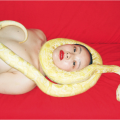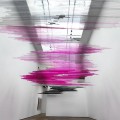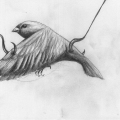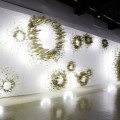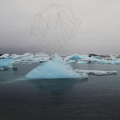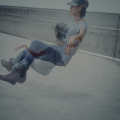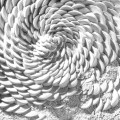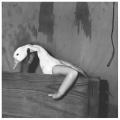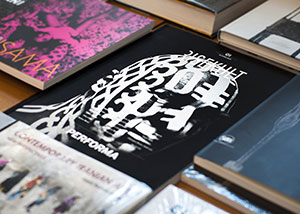Paola Angelini spent three months in Norway during the spring and summer of 2014 as artist-in-residence at the Nordic Artists’ Center (NKD) in Dale, Sunnfjord. Dale is located midway between fjord and mountain in the Dalsfjorden and is a small rural community with a population of 3,000. The nearest town is 150 km away.
Angelini has had Venice as her fixed base since 2013. The contrast with the tiny village of Dale in Sunnfjord could hardly be greater. Dale has nothing in common with the floating city’s centuries-long political, cultural and urban history and which has contributed to shape our understanding of the world as the starting point for great discoveries.
Venice, on the other hand, has nothing in common with Dalsfjorden’s lush forests and mountains. There are more than 200 rainfall days in the year and everyday life is dominated by the natural elements. The meteorological conditions, as well as the strong seasonal changes, affect how we define ourselves in relation to the natural conditions and landscape here. The experience of nature is ever present, whether it is the white chill of winter, the golden and red shades of autumn or the intense variations of green which dominate the summer.
Just as remarkable as the lack of nature is in Venice, the intimate and stubborn presence of nature is in Dale. When you leave your home, you step out, literally, into nature, into the forest.
However, this place is not lacking in culture, it is just not expressed as a centuries’ old palace, large public squares or ancient sculptures which tell us about the civilisation of earlier times. Sunnfjord’s palaces and squares are its forest, mountains and fjord, naturally more in a metaphorical than in a real sense. Nonetheless, today’s inherent natural premises, as in earlier times, are the roots of mythology, mysticism, folklore and history. Proximity to nature forms the basis of Norwegian culture. For example, it is not by chance that historical painting never achieved a leading status in Norwegian art history. This position has been held by landscape painting.
THE TRANSITION
When Paola Angelini came to NKD, she did not only bring with her canvas, frames and paint. Just as important was a range of subjects and artistic experience anchored in classic form and content. She expressed this herself during an atelier discussion whilst at NKD as: “in my first attempts at landscape painting, my understanding of the landscape was influenced by history. I mean art history”.
To emphasise this point, Angelini would compare the landscape with a ruin – that is to say, transformation of nature into culture. She also specifically says in respect of the Italian landscape, that it is linked to history, culture and religion, in contrast to how she views the Norwegian landscape. It is clear that this understanding of the landscape is dominant in her first approach to the local topography.
We can see this in the paintings which she completed in the first weeks of her stay. The characteristic fjord landscape around Dale serves primarily as a formal background for stories which, in both style and content are rooted in art history. In époques which lie centuries back in time. It is an interesting iconography; to compare classical art historical subjects with the landscape of western Norway, but understanding of the landscape fails with a scenographic attitude. In these paintings we find little of the unfiltered landscape experience which she acquired during the course of her stay.
Her meeting with Norwegian nature – or experience of the Norwegian essence – was therefore almost without references, and totally different from her Italian experience of nature. Nevertheless, these different experiences are not completely dissimilar, and are probably a precondition for her credible understanding of the Norwegian landscape. Her experiences of nature in Dale would also appear to touch upon a “Norwegian” understanding of the landscape as a spiritual space. It is as if, during her time in Norway, she intuitively acquired this local understanding of “the landscape space”. The conception that the ideal natural experience is a solitary experience of a “purely” natural space is in fact deeply rooted in the Norwegian natural character. Not only literally, but just as much metaphorically – that means both a landscape and an experience untainted by culture and civilisation.
Viewed in comparison with this, together with Angelini’s own experience of nature during her stay in Norway, there are reasons to believe that this led to a new attitude towards, and understanding of, the natural landscape. Not only in respect of what is Norwegian, but also the presence of nature in the human experience in general, where the landscape – the natural space – is understood as an independent and adequate concept.
“LANDSKAPET”
Angelini’s stay at NKD culminated in a grandiose landscape painting or a forest interior as we would prefer to call it in Norwegian. The work not only appears as the fertile result of several weeks’ intense work in foreign surroundings, but, with this painting, she joins the ranks of a dominant tradition in Norwegian art history – landscape painting.
This large forest painting, which she has called “landskapet”, is not only a subjective interpretation of the forest landscape around NKD, but is also an exercise in perception where the foreground, middle ground and background appear equally close and present in the painting. However, the painting does not appear flat. It has a central pulling power, which draws the viewer’s sight inwards into the painting and thus balances the potentially flat experience. Another point is that no single element of the picture is more important than the others. To put it another way, there is thus also a recognition that nature’s elements are mutually dependent upon each other, and equally valuable to be able to create the great totality. This not only implies a poetic attitude towards the equality of all things, but is also the expression of an ecological consciousness of the balance which maintains a sustainable nature. Thus the painting is also a story of the premise and foundation for our very existence.
“LANDSKAPET” OUTDOORS
The painting is the result of an energy-intensive outdoor exercise. She says herself that it was absolutely necessary for the creation of the huge forest painting that it be painted outdoors. Not as a romantic reiteration of the modernistic “en plein air” tradition, but simply as a necessity to approach the subject as closely as possible.
Of course the painting was not created out of the blue. It was the result of a gradual and slow process, as part of gradually getting used to the landscape of western Norway. The early, more scenographic paintings were an obvious necessity, but also the fine and intimate “Study of Forest” has to be mentioned, not only in the coloration and formal approach, but just as much as the acculturation of the subject. In a way, Angelini cracked the Norwegian landscape code in this small painting. If we observe these paintings side by side – the large one and the small forest landscape, it is clear that whereas the small study suggests and tries by trial and error; whether it is the form, colour or content, the large painting springs out in full flower. This performance in green – almost an acrobatic c-moment – which is demonstrated in “Landskapet”, smoulders as a possibility in the “Landscape Study”.
To paint outdoors can on its own represent an ordeal with gusts of wind, variations in temperature and annoying insects. However, the greatest challenge of all was the ever-changing light conditions throughout the day. Other “en plein air” artists have turned this challenge into a method whereby the motive is worked upon in parallel, and where it is the light conditions at any one time which determine which canvas to work upon.
The challenge for Angelini was a synthesis of changing perceptual conditions. Even though the Nordic summer day is long and the night is light, this does not mean that light conditions do not vary over a wide scale, even during the midday hours. Nevertheless, as Angelini said, when the painting came into the studio, it was as if part of the forest came into the house.
Face to face with this huge canvas it is also easy to understand what she means, and where she has succeeded. The painting almost exudes the forest’s steamy fragrance. Even though the approach to the pictorial is in the direction of an abstract expression, the painting is full of details which present a general execution of the Norwegian “forest”. It is mentioned that the perceptual hierarchy is dissolved in the painting in that each perspective level is equally important. This claim is underlined exactly by this feeling of the forest’s presence. It is not only experienced as though a part of nature seems to be preserved and brought indoors. Just as apparent is the illusion of almost being within the forest. One is surrounded by the stoic presence of the spruce, the wilderness of the coppice and the undergrowth’s soft cover of earth, moss and grass. This is what gives the forest the characteristic fragrance of something originally clean, whether it is sun and dryness or rain and dampness. It can be claimed that the “en plein air” painting’s unique and demanding working method is to reach as true an expression as possible. She has, to the degree which is possible, removed cultural filters which an artist always carries in the creative process. She has adopted the line of confrontation instead of the protective and safe bubble which the atelier represents. This is not intended to resist, but to “be as one” with the subject, by literally going into it and actually standing inside it in the creative process.
This landscape is no longer just an observation, a closely meditated extract of a chaotic and uncultivated nature; that is to say, a precisely thought-out staging of nature. Angelini’s painting is a confrontation with this nature – the endurance of an environment which cannot be controlled. By going into nature in this way and trying to reproduce the truest possible image of the experience, in relation to the artist’s abilities and perception. A well-known Norwegian artist’s postulate “I paint what I saw, not what I see” seems relevant, in a paradoxical way, in spite of the fact that we know how the painting was created. The meaning of this statement is of course subject to interpretation. It is not the direct and “correct” reproduction of the subject, which is the truest expression for the artistic transformation which takes place on the canvas. It is the sum of the artist’s experience, knowledge, expectations, wishes and ambitions.
This corresponds very well with Angelini’s artistic attitude as expressed in “Landskapet”. For even though the forest’s “presence” is indisputable, we are not looking at an exact copy of nature. Nevertheless, it would not be more than a painting of something, whilst we are faced with the subjective experience of something. The convincing presentation of this experience is what gives the painting its true character, and lifts it up into the world of artistic experience.



















